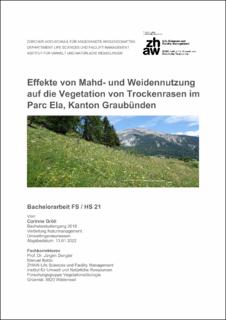Bitte benutzen Sie diese Kennung, um auf die Ressource zu verweisen:
https://doi.org/10.21256/zhaw-25257| Publikationstyp: | Thesis: Bachelor |
| Titel: | Effekte von Mahd- und Weidennutzung auf die Vegetation von Trockenrasen im Parc Ela, Kanton Graubünden |
| Autor/-in: | Gröli, Corinne |
| Betreuer/-in / Gutachter/-in: | Dengler, Jürgen Babbi, Manuel |
| DOI: | 10.21256/zhaw-25257 |
| Umfang: | 45 |
| Erscheinungsdatum: | 2022 |
| Verlag / Hrsg. Institution: | ZHAW Zürcher Hochschule für Angewandte Wissenschaften |
| Verlag / Hrsg. Institution: | Winterthur |
| Sprache: | Deutsch |
| Schlagwörter: | Biodiversität; Brachypodium rupestre; Mahd; Naturschutz; Parc Ela; Schweiz; Trockenrasen; Verschachtelte Vegetationsaufnahme; Weiden; Wiesen; Biodiversity; Brachypodium rupestre; Dry grasslands; Meadow; Nature conservation; Nested vegetation plots; Parc Ela; Pasture; Switzerland |
| Fachgebiet (DDC): | 333.7: Landflächen, Naturerholungsgebiete 577: Ökologie |
| Zusammenfassung: | Throughout Europe species-rich seminatural dry grasslands are threatened by an increasing loss of habitat extend and a decrease in habitat quality. Two main drivers for the ongoing loss of biodiversity in dry grasslands are land-use intensification and abandonment. Therefore, proper management methods such as extensive mowing and grazing are needed to preserve those seminatural habitats. Because such management is expensive and mostly not profitable it is important to use the limited resources for the most beneficial method. This study aims to gain a better understanding of the patterns caused in the vegetation when mowing or grazing is applied as a management method. The study was carried out in the Parc Ela, a Regional Nature Parc in the eastern Swiss Alps in the Canton of Grison. 32 vegetation plots (nested-plot series of 0.0001 to 10 m2) were recorded in meso-xeric grasslands of four different regions. In each region four plots were managed by mowing and four by grazing. Species richness, Shannon index, Shannon evenness and z-values were used to assess biodiversity. Seven ecological indicator values, the three CSR-strategy types and four functional traits as well as four abiotic and two structural parameters were analysed. Patterns for biodiversity and functional traits were not clear and hence a recommendation for either mowing or grazing could not be made. It is assumed that various interactions with soil parameters and other abiotic factors may play a role since soil pH and all ecological indicator values except for one showed significant regional differences. Differences regarding management methods were mainly found for functional traits and strategies. Surprisingly, many of them showed the opposite pattern from what was expected based on the results of other studies. A definite explanation for these controverse results could not be found. However, there is an assumption that at least parts of that pattern may be connected to a relative high abundance of the invasive tall grass species Brachypodium rupestre. Because this species is unpalatable for domestic herbivores, grazing, specifically in extensively managed pastures where there are enough other food sources, can promote the spread of Brachypodium rupestre. An increasing dominance of Brachypodium rupestre may alter the structure of a plant community and species composition, leading to a loss of biodiversity. Abundances of Brachypodium rupestre were significantly higher in pastures than in meadows. Since this stress tolerant competitor has functional traits that would predominantly be expected in meadows, it is assumed that this may have influenced the management related results for strategy types and functional traits. In view of conservation measures it is therefore recommended to keep the spread of Brachypodium rupestre under control which may best be done with a mixture of early grazing and late mowing. |
| URI: | https://digitalcollection.zhaw.ch/handle/11475/25257 |
| Lizenz (gemäss Verlagsvertrag): | CC BY 4.0: Namensnennung 4.0 International |
| Departement: | Life Sciences und Facility Management |
| Enthalten in den Sammlungen: | Bachelorarbeiten Umweltingenieurwesen |
Dateien zu dieser Ressource:
| Datei | Beschreibung | Größe | Format | |
|---|---|---|---|---|
| 2022_Gröli_Corinne_BA_UI.pdf | 1.98 MB | Adobe PDF |  Öffnen/Anzeigen |
Zur Langanzeige
Gröli, C. (2022). Effekte von Mahd- und Weidennutzung auf die Vegetation von Trockenrasen im Parc Ela, Kanton Graubünden [Bachelor’s thesis, ZHAW Zürcher Hochschule für Angewandte Wissenschaften]. https://doi.org/10.21256/zhaw-25257
Gröli, C. (2022) Effekte von Mahd- und Weidennutzung auf die Vegetation von Trockenrasen im Parc Ela, Kanton Graubünden. Bachelor’s thesis. ZHAW Zürcher Hochschule für Angewandte Wissenschaften. Available at: https://doi.org/10.21256/zhaw-25257.
C. Gröli, “Effekte von Mahd- und Weidennutzung auf die Vegetation von Trockenrasen im Parc Ela, Kanton Graubünden,” Bachelor’s thesis, ZHAW Zürcher Hochschule für Angewandte Wissenschaften, Winterthur, 2022. doi: 10.21256/zhaw-25257.
GRÖLI, Corinne, 2022. Effekte von Mahd- und Weidennutzung auf die Vegetation von Trockenrasen im Parc Ela, Kanton Graubünden. Bachelor’s thesis. Winterthur: ZHAW Zürcher Hochschule für Angewandte Wissenschaften
Gröli, Corinne. 2022. “Effekte von Mahd- und Weidennutzung auf die Vegetation von Trockenrasen im Parc Ela, Kanton Graubünden.” Bachelor’s thesis, Winterthur: ZHAW Zürcher Hochschule für Angewandte Wissenschaften. https://doi.org/10.21256/zhaw-25257.
Gröli, Corinne. Effekte von Mahd- und Weidennutzung auf die Vegetation von Trockenrasen im Parc Ela, Kanton Graubünden. ZHAW Zürcher Hochschule für Angewandte Wissenschaften, 2022, https://doi.org/10.21256/zhaw-25257.
Alle Ressourcen in diesem Repository sind urheberrechtlich geschützt, soweit nicht anderweitig angezeigt.